Solar-powered travel has revolutionized since panel prices plummeted from $100 per watt to less than $0.50 in the last 45 years. This incredible technology now powers your outdoor adventures, whether you camp off-grid or visit remote destinations.
Your travel trailer’s solar panels can generate between 1,000 and 3,000 watts of power—enough to run all but one of these appliances while off-grid. Solar power options range from compact cell phone chargers that fit in your backpack to complete charging stations for your RV. These breakthroughs make green travel more available today. Solar panel camping has become practical, and choices include lightweight teardrop trailers with 100-watt panels and sophisticated campers that power multiple devices at once.
This article will provide you with the best solar-powered travel gadgets for 2025. You’ll learn how to select the right system that matches your needs and what today’s most advanced products offer.
Table of Contents
Top solar-powered chargers for phones and devices
Keeping your devices charged becomes a priority if you’re away from power outlets during solar-powered travel. A good solar charger could be the difference between staying connected and having dead devices in remote places.
Best solar-powered cell phone charger options
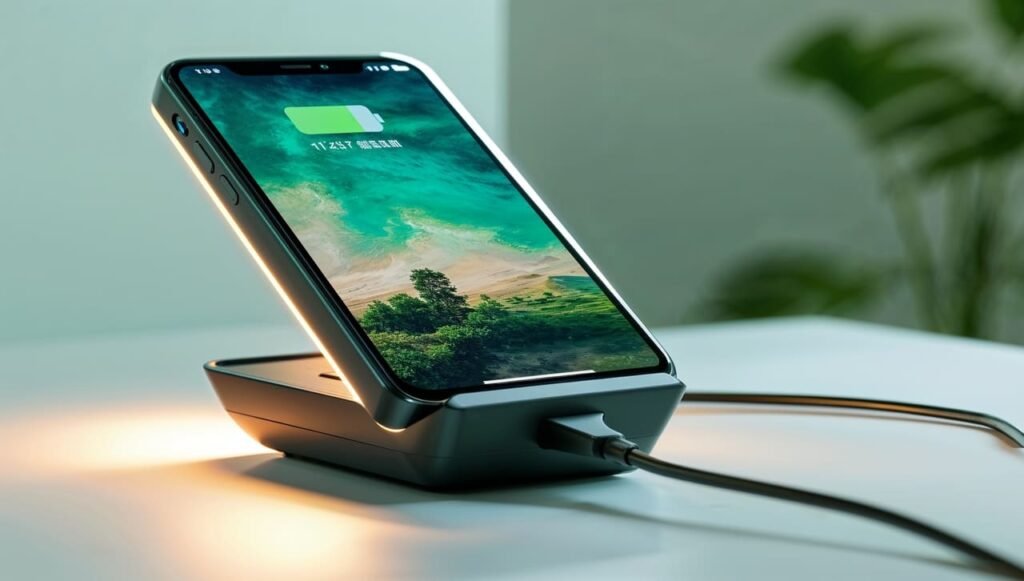
The solar-powered cell phone charger market has grown significantly, and there are several excellent options for 2025. We tested 13 different models in various conditions, and a few clear winners stood out.
Top performers include:
| Model | Power Output | Weight | Best For | Notable Features |
|---|---|---|---|---|
| Allpowers SP012 | 100W | 4.9 lbs | Multiple devices | 15 panels, 3 USB ports, weatherproof |
| BigBlue 28W | 28W | 1.4 pounds | Backpacking | Book-sized, charges in 5 hours |
| Neckteck 21W | 21W | Ultra-light | Hiking/Camping | Outstanding output-to-weight ratio |
Power output compared to cost should be your first consideration. Most panels don’t reach their maximum output even in bright sunlight, so it’s worth checking the actual power from USB-A and USB-C ports. Make sure the available ports match your devices before you buy.
You’ll find three main types of solar chargers: portable panels for direct charging, power banks with built-in solar, and bigger panels that need a power station in between. Campers should pick based on their power needs and how much they’ll move around.
Charging speed and battery compatibility
Several things affect how fast solar charging works. These Tests show that solar chargers work almost as well as wall chargers. A solar charger needs about 60.33 minutes to charge a phone by 50%, while a wall charger takes 58.66 minutes.
Here’s what different devices need for battery capacity:
- Smartphone: 3,000-4,500 mAh
- Tablet: 7,000-12,000 mAh
- GPS Device: 2,000-3,000 mAh
- Action Camera: 1,000-2,000 mAh
Weekend trips with 1-2 devices need a 10,000-20,000 mAh capacity. Longer trips with more devices require 20,000-30,000 mAh. All the same, be practical about what solar charging can do – a typical 5W solar panel produces about 1000mAh per hour in perfect conditions.
Solar panels work best between 11:00 AM and 2:00 PM. Seasons and clouds affect their performance. Putting your panel in the right spot makes a big difference in charging speed.
Foldable vs. fixed panel designs
Your travel style and solar-powered camper setup will determine whether you need foldable or fixed panels.
Foldable panels are super portable. They weigh between 5 and 15 pounds, and even 200W panels can fit in a suitcase. You can set them up in 5-10 minutes, and many come with kickstands and charge controllers. This makes them perfect for camping with solar panels if you move around a lot.
Related read: Electric Camper Jacks For Travelers.
Fixed panels are more efficient and last longer. New rigid monocrystalline panels can be 22% efficient, and the best ones make over 300 watts per panel. They’re not as portable, but they work great on a travel trailer with solar panels or an RV roof.
Fixed panels don’t need much adjustment or maintenance, which is suitable for full-time travelers. They work best with a vehicle parked in direct sunlight and are most efficient with the sun right overhead.
Portable panels allow backpackers and occasional travelers to move them around throughout the day, helping them better adapt to changing conditions at campgrounds.
Solar-powered lighting and cooking gear
Solar-powered travel requires lights and cooking equipment that people often overlook. Solar energy can improve your camping experience with environmentally responsible lighting and meal preparation solutions.
Portable solar lanterns and string lights
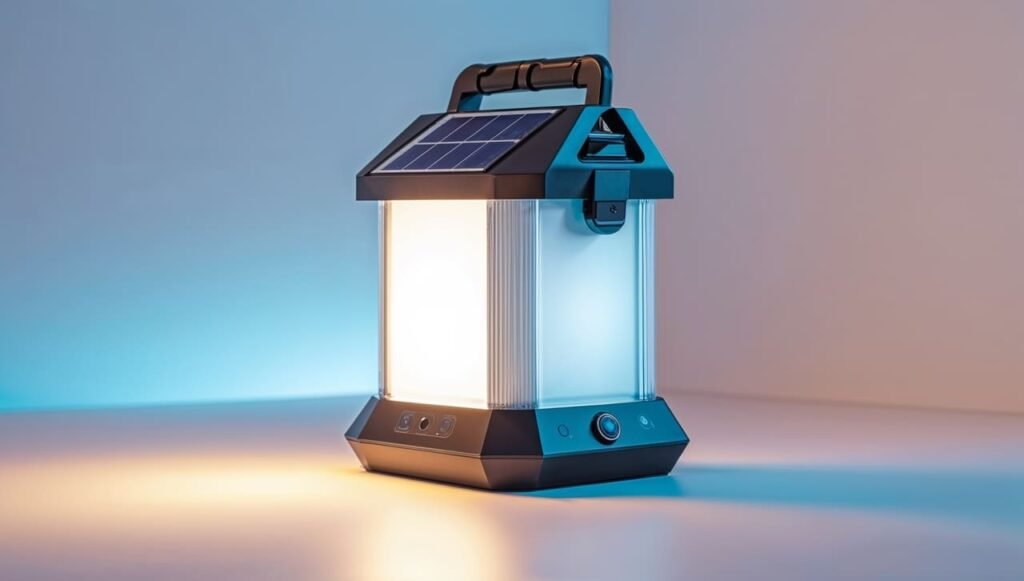
You can light up your campsite without draining batteries or needing electrical hookups. Modern solar lanterns have evolved from simple lights to multi-functional tools that can charge your devices, too.
LuminAID’s PackLite Max Quick Inflate Solar Lantern excels with up to 200 lumens and five lighting modes. This waterproof, inflatable lantern runs for up to 50 hours on low settings. It also doubles as a phone charger, making it perfect for backpacking trips.
BioLite Luci 44′ Solar String Lights create a perfect ambiance with their detachable power hub. You can charge it separately while keeping your lights installed. With a full 16-hour solar charge, these string lights can create a perfect campsite atmosphere.
Goal Zero’s product line includes the versatile Crush Light, which has three light settings and a flickering candle mode. The Lighthouse 600 Lantern delivers 600 lumens while serving as a USB power hub for small devices.
Popular solar camping light options:
| Product | Max Lumens | Run Time | Special Features |
|---|---|---|---|
| LuminAID Max | 200 | Up to 50 hours | Inflatable, phone charging |
| Goal Zero Lighthouse 600 | 600 | Varies | USB charging hub |
| MPOWERD Luci Outdoor 2.0 | 75 | 24 hours | Lightweight, affordable |
| Brightech Glow String Lights | Ambient | Automatic dusk activation | WeatherTite commercial cables |
Solar-powered stoves and ovens for camping
Solar cooking provides an environmentally responsible way to prepare meals outdoors. These devices need no fuel, create zero emissions, and reach impressive cooking temperatures.
Sun Oven’s products have led the market since 1986 as some of the most versatile solar cookers available. You can cook, bake, dehydrate, slow-cook, or boil food using everyday cookware. Solar ovens work silently, and you can use them during summer fire bans since they produce no flame.
Solar cookers work on three principles: concentrating, capturing, and conserving the sun’s rays. They come in several types:
- Box cookers: Reach 120-180°C, perfect for gentle cooking that preserves nutrients
- Parabolic cookers: Exceed 200°C, allowing for frying and grilling
- Vacuum tube cookers: Reach temperatures above 290°C and can heat even in cloudy conditions
With these solar options, you can prepare almost anything you would in a conventional kitchen. Box-style solar ovens heat up to 90-200°C and fit multiple pots at once. Parabolic designs focus light directly onto the cooking vessel and reach higher temperatures for frying and broiling.
How long do they last on a single charge?
Battery life varies between lighting and cooking products. LuminAID Max lanterns run up to 50 hours on low settings after a full charge. MPOWERD Luci Outdoor 2.0 lights your camp for about 24 hours.
Solar string lights typically run 6-10 hours after a full day’s charge. Premium models like Brightech claim to work for nearly 1,000 hours over their lifespan.
Solar ovens take longer than conventional methods to cook food. Simple pizza box-style solar ovens need 45 minutes to melt cheese on a tortilla. Advanced models cook meals in timeframes similar to traditional cooking:
- Box ovens: 1-3 hours for most meals
- Parabolic cookers: Minutes for frying, identical to conventional stoves
- Vacuum tube ovens: Cooking times match electric/gas cooking
Sunlight conditions affect solar cooking times. Summer allows cooking from 8 a.m. to 6 p.m., while winter limits optimal cooking to 10 a.m. to 2 p.m. These cooking solutions complement your sustainable power system perfectly when you travel with a solar-equipped trailer.
Solar coolers, fridges, and fans for off-grid comfort
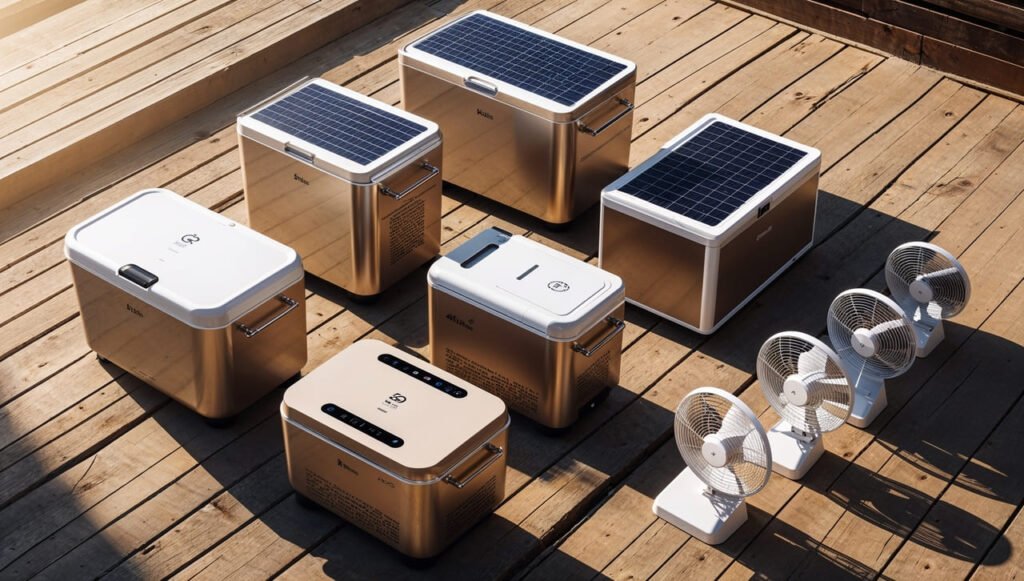
You need specialized solar-powered equipment to stay calm and comfortable during off-grid adventures. Solar-powered travel has become more relaxed than before, thanks to modern technology that lets you enjoy refrigeration and air circulation without traditional power sources.
Top solar-powered coolers for 2025
Solar coolers have changed the way we store food and beverages in remote locations. These smart devices don’t need ice, which keeps contents dry and neat.
These coolers charge through wall outlets (120V AC), 12V DC outlets, or portable power stations. They work differently from traditional coolers, converting the sun’s energy into stored battery power instead of using ice.
How solar fridges work in travel trailers
Travel trailers with solar panels use either absorption or compressor technology for their solar fridges. New models typically use 12V compressor systems that need 3-5 amps per hour while running, which adds up to 30-60 amp-hours each day.
Campers with solar panels get several benefits from these refrigerators:
- Direct operation from solar panels without batteries (though batteries help after sunset)
- Modern units come with “power save” modes that use less power
- Some people save 250-300 dollars in propane each year by running absorption fridges through inverters
A 400- 600W solar array paired with these fridges works well during sunny days, and batteries provide power at night.
Best solar fans for tents and RVs
Good airflow makes confined spaces comfortable. The GoSun Breeze is one of the best portable fans you can buy. It runs straight from solar chargers as long as there’s sunlight.
The ITehil Portable Solar Fan has a 10,000mAh battery capacity, dual charging ports, and runs for 10-24 hours on one charge. Solar-powered RV owners love the Ryobi 18-Volt/120-Volt One+ Hybrid Fan, which works with both battery and AC power and runs up to eight hours on low settings.
RV owners should look for fans that work with multiple power sources (12V, battery, and 110V) to keep the air flowing in all conditions.
Best solar generators and power stations
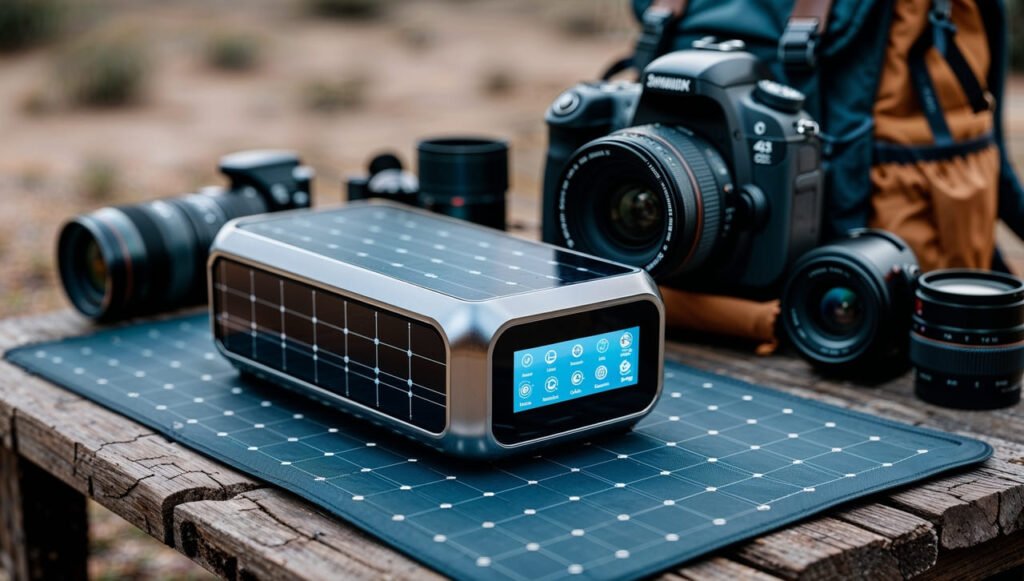
Portable solar generators and power stations are the foundation of your solar-powered travel system when you go off the grid. These versatile units store energy from solar panels and give you reliable power on demand.
Top picks: BLUETTI, Jackery, and more
We tested many models and found several top performers in 2025:
| Up to 12.29 kWh | Capacity | Output | Special Features |
|---|---|---|---|
| Jackery Explorer 2000 Plus | 2042Wh | 2200W | Expandable with external batteries |
| EcoFlow River 2 Pro | Variable | High power-to-size ratio | Durable, user-friendly interface |
| Bluetti AC300+B300 | 3000W | Up to 12.29kWh | LiFePO4 batteries with 3,500 cycle lifespan |
Jackery delivers reliable performance that travelers love. Their units come with wireless charging and work with solar panels of all types. Bluetti’s LiFePO4 batteries make their units more stable and better for the environment than traditional lithium NMC batteries.
How to size your solar charging station
Your solar charging station choice depends on a few key factors:
Start by calculating your watt-hour (Wh) capacity needs based on your devices. A watt-hour shows watts per hour – a 300Wh battery can run a 300W device for one hour.
The power output rating matters too. Look for at least 200W if you want to charge multiple devices at once. The unit should have a pure sine-wave inverter that safely powers appliances with motors or critical equipment like CPAP machines.
Expandable battery options for long trips
Your travel trailer with solar panels needs flexible power options for longer trips:
Jackery’s Explorer 1000 Plus works with three extra batteries, expanding its capacity from 1.25 kWh to 5 kWh. Bluetti’s AC300 model connects to four B300 battery modules and creates a 12.29 kWh storage system. That’s close to home battery capacity but costs less.
The Anker Solix F3800 takes it further with a massive 53.8 kWh total capacity when you add more batteries. This makes it perfect for solar-powered RV users who need lots of off-grid power.
Solar panels for campers, RVs, and trailers
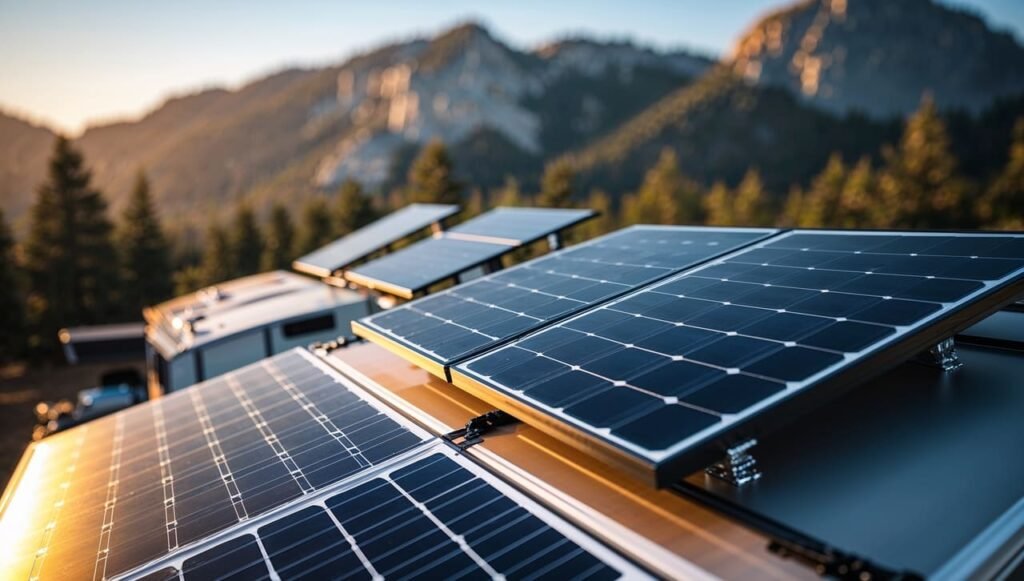
Solar panels are the foundation of energy independence for recreational vehicle owners. Panel costs have dropped more than 80% since 2010, making solar system installation more affordable than ever.
Choosing the right panel for your solar-powered camper
Types of panels differ substantially in efficiency and application:
| Panel Type | Efficiency | Cost | Best For |
|---|---|---|---|
| Monocrystalline | 15-20% | ~$1.25/W | Maximum power output, limited space |
| Polycrystalline | Lower | ~$1.00/W | Budget-conscious travelers |
| Amorphous/Thin-film | ~10-11% | ~$0.69/W | Curved surfaces, high temperatures |
Start by evaluating your daily power needs. A setup of 100-200 watts is enough for simple needs like charging devices and running LED lights. Energy-hungry appliances might need 400+ watts. Most solar-powered RV enthusiasts discover that 1,000-3,000 watts enables unlimited off-grid living.
Your roof space matters too. Limited space calls for high-efficiency monocrystalline panels that produce more power per square foot. A smart first step is to test-fit cardboard cutouts of potential panels with mounting brackets to verify the fit before buying.
Installation tips for a travel trailer with solar panels
The success of your travel trailer with solar panels depends on these crucial factors:
- Mount panels in spots with maximum sunlight exposure, away from shade-causing obstacles like AC units and vents
- Secure rigid panels using screws with self-leveling sealant under brackets to ensure waterproofing
- Place charge controllers inside your RV as close to the batteries as possible
Double-check all wiring connections before the final hookup, as incorrect polarity can damage components. Note that solar panels generate electricity whenever light hits them, so treat all connections as live circuits.
Portable vs. roof-mounted panels
Your travel style largely determines whether portable or roof-mounted systems work better:
Roof-mounted advantages:
- Continuous energy collection (even while driving)
- Better protection from theft and weather
- Efficient use of available roof space
Portable panel benefits:
- RV can stay in the shade while panels soak up the sun
- Easy angle and direction adjustments for optimal exposure
- Installation requires no drilling or permanent changes
Both systems achieve the same goal—clean, quiet power without generators or hookups. Portable systems equipped with 25-foot cables offer positioning flexibility without compromising performance.
Conclusion: Solar-powered travel is the future
Solar-powered gadgets have changed how we explore the outdoors while staying connected and comfortable. This piece shows state-of-the-art solar technology that makes environmentally responsible travel possible and convenient. The options in 2025 work for every type of traveler, from small phone chargers in your backpack to complete power stations that run multiple appliances.
Without doubt, solar panels cost much less now, dropping from $100 per watt to under $0.50 over the last four decades. This makes the technology available to almost everyone. Your travel style helps decide which solar solutions fit best. Weekend campers might only need a portable charger and a lantern. Full-time RV enthusiasts do better with complete roof-mounted systems that generate 1,000-3,000 watts of clean energy.
Modern solar technology does more than charge devices. Solar-powered cooking equipment eliminates the need for propane or other fuels. Solar refrigeration keeps food fresh without ice. Fans and cooling systems keep you comfortable in any climate, all powered by sunlight alone.
Today’s solar equipment stands out for its versatility. Foldable panels let you move around easily, while fixed installations give steady power generation. Power stations grow with your needs, so you can start small and add more as your off-grid adventures grow.
Solar-powered travel goes beyond new technology—it gives you freedom. Knowing how to make your electricity lets you go deeper into remote spots, stay longer, and help the environment. You won’t need noisy generators or crowded RV parks with hookups anymore.
You’ll need to research to pick the right solar equipment. But quality solar gear pays off with years of reliable service that requires no maintenance. Solar technology gets better faster, making equipment more efficient, lighter, and cheaper each year.
A world of off-grid travel waits—powered by pure sunshine.
FAQs Related to Solar-Powered Travel Gadgets
What are the best solar-powered chargers for phones and devices in 2025?
Top performers include the Allpowers SP012 with 100W output, the BigBlue 28W for backpacking, and the Neckteck 21W for hiking and camping. When choosing a charger, consider power output, weight, and compatibility with your devices.
How do solar-powered coolers work, and what are some top options?
Solar coolers convert solar energy into electricity stored in a battery, eliminating the need for ice. Notable options include the Anker EverFrost 50 with a 50L capacity and 42-hour battery life, and the ACOPower LionCooler X50A, a 52-quart battery-powered fridge freezer.
What should I consider when choosing solar panels for my RV or travel trailer?
Assess your daily power consumption, available roof space, and travel style. For basic needs, 100-200 watts may suffice, while 400+ watts might be necessary for energy-intensive appliances. Based on efficiency needs and budget, consider panel type (monocrystalline, polycrystalline, or thin-film).
Are portable or roof-mounted solar panels better for camping?
The choice depends on your travel style. Roof-mounted panels collect energy continuously and are theft-resistant, while portable panels offer flexibility in positioning and don’t require permanent installation. Both can provide clean, quiet power without generators or hookups.
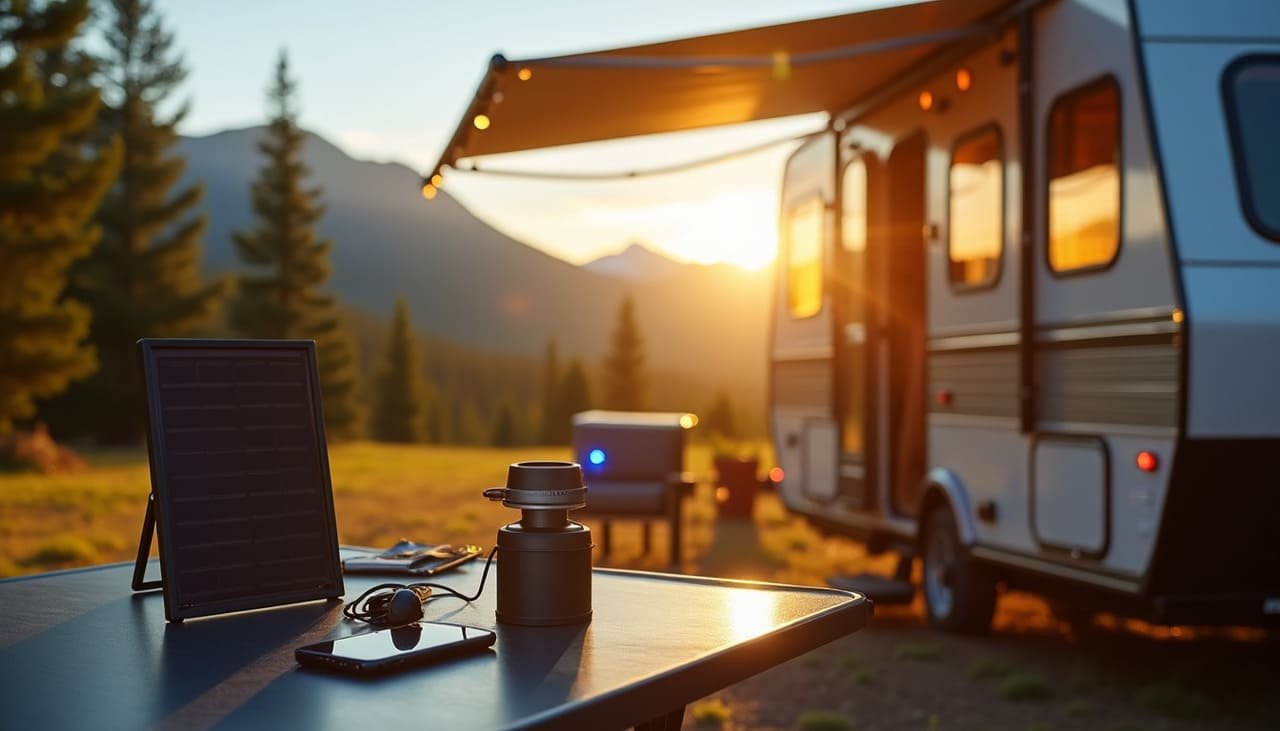

Leave a Comment